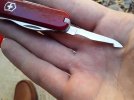So for anyone still wondering, the 3/32" (2.38mm) rod did not fit through the backside pivot holes in the aluminum sideplates on the 84mm Waiter. You could drill those sideplate holes a bit larger to make the rod fit, and that would certainly be a lot easier than filing/sanding down the rod. But as it was already pointed out, this means removing material right at the edge which will risk making it just a little bit more structurally weaker. I personally don't think it would make that much difference, but I am not the expert here. I will say that I think it would probably make the most difference for the corkscrew when compared to the amount and direction of force put on this area by any of the other tools. You're pulling straight up when uncorking wine. None of the other tools are used like that except for the parcel hook, which basically nobody uses anyway. Let's be real.

Anyway, I did the next part the hard way on purpose. I laid some pieces of sandpaper flat and I sanded the end of the brass rod by hand, starting with 120 and 240 grit. I slowly rolled the rod around between my thumb and forefinger as I pushed it back and forth across the sandpaper, to make sure I was sanding the rod evenly all the way around. I stopped periodically to test fit the rod in the sideplates. Once I had about 1/4" poking through the other side of both plates, I switched to 400 grit, then 800, then 1200, and finally 3000 to polish. Next I put the rod back in and notched it 1/4" away from the sideplate, pulled it back out, and began sawing through it at this point. I could have used cutters, but I wanted to do it the hard way. I could've also used a hacksaw, but I opted instead to use the sawing edge of a metal file from a 91mm SAK. This actually took around 7-10 minutes, which was longer than I expected, but the file itself was fairly old and worn.
I then sanded the cut end to smooth and round it out, and then I repeated the sanding process on the cut side of the piece of rod until the whole piece was able to fit all the way through both both plates and come fully out through the other side.
I have digital calipers. I could've used them to measure the rod's diameter to get it evenly down to 2.2mm (or close enough). I could also have used a power drill to turn the rod while I pressed a diamond coated file into it, to reduce the diameter more easily. I chose not to do any of these things because I am trying to prove that this can all be done by hand with minimal skill and a few common inexpensive tools. So far I've just used sandpaper and a metal saw from a swiss army knife. You could substitute that with a cheap hacksaw blade instead.
So now the rod piece is sitting in the assembled SAK, 1/4" poking out on either side, waiting to be peened. The backside phillips is in place and all tools have a good snap. I ordered a small peening hammer for 15 bucks and I am just waiting until I can use it.
Let's just see how badly I @#$% up the peening.

Oh by the way, the 3/32" brass rod I bought is K&S #8163, Made in USA.







